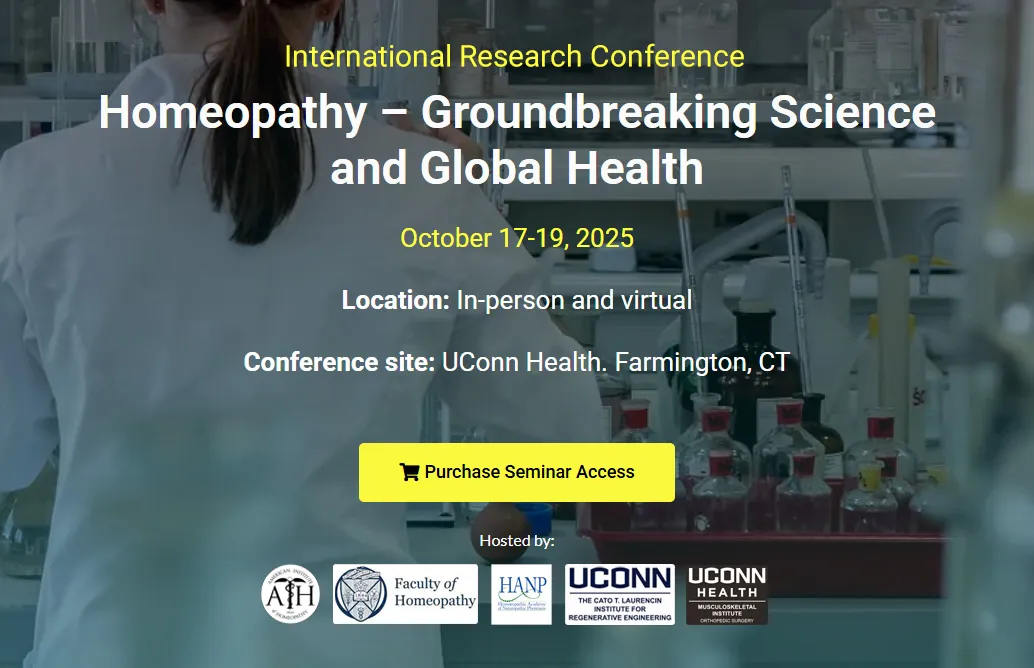
President’s Message: Returning to Our Roots
Dear Esteemed Colleagues,
This past month the American Institute of Homeopathy along with the Homeopathic Academy of Naturopathic Physicians (HANP), The Homeopathic Nurses Associations (HNA) and the Academy of Veterinary Homeopathy (AVH) worked very hard to present a collaborative conference titled “Returning to our Roots.” The mission of this conference, that was held at the Sonoran University of Health Sciences in Tempe, Arizona, was designed to take us back to our roots. What does this mean and why would we want to do this?
The answer to these questions starts with the word foundation: when we have a solid foundation, we can stand strong no matter what the storm. This solid foundation both in philosophy and practice laid down for homeopathy by Samuel Hahnemann and his first students, including Clemens Von Bönninghausen, has been responsible for the success and continued survival of over 200 years of homeopathy. It is vital that we study the foundation of homeopathy over and over. Thanks to the free on-going access to the George Dimitriadis library on the Sonoran University of Health Sciences web page we could read, for example, firsthand descriptions of cases of children who ate Belladonna berries, then see how Hahnemann used these often tragic toxicology reports to form the early materia medica. We could then learn how these symptoms were organized into a repertory that was created by Bönninghausen. The Hahnemann Institute of Sydney kindly donated a free month of access to Bönninghausen’s Therapeutic Pocket book (TBR2) software for every attendee so we could all follow along when cases were presented and practice cases on our own. It was the specific intention of the speakers and organizers to limit our practice cases to the Bönninghausen’s repertory for this conference. It forced us to focus more on our foundation, to fine tune our skills in that regard.
There are several very successful physicians in the US and more commonly across the world who use the TBR2 repertory most of the time. When I inquired about this, I was reminded that Hahnemann’s remedies alone represent 68,000 symptoms and 1 million printed words. Hahnemann indicated in later editions of the Organon that we have enough remedies to use and we don’t need to hanker after more. This list of symptoms represents 125 different remedies that the majority of the time will produce cures for our patients. However, there are some very well-known remedies, such as Apis mellifica, Gelsemium sempervirens and Kali bichromicum, not represented in the TBR2. For some people, this alone is reason enough not to use this repertory. While it may be true that from time to time the best remedy may not be found in the TBR2 repertory, this is relatively rare. The repertory is just a tool; we must still always first take a complete case. When the remedies indicated in case analysis from the repertory don’t match the materia medica, we must dig deeper. Too often however, many of us are looking for other remedies to prescribe when in reality the indicated remedy is probably represented in one of those 125 remedies.

Some would state, “I don’t want to learn another approach.” I thought that at first too, but this approach is exactly the same as our classical one—we always take the complete case. We still must understand what needs to be treated (the complaint). We still must understand the exact location of the symptom, the sensations felt, the modalities and any concomitants. What is different is the layout of this repertory; however its simplicity is so refreshing and easy to master, especially if you can understand how Hahnemann built the materia medica and how Bönninghausen extracted that material and systematically made a reference for us to look up symptoms.
When we know this small repertory inside and out, and when we know the 125 remedies inside and out, our accuracy of prescribing in acute and chronic diseases will soar. Our goal should be to encourage as many people as possible to establish and re-establish this foundation. When the accuracy of our prescribing increases, then the respect afforded to homeopathic practitioners in our country will return to what it once was. When this happens, more and more patients will recover from severe conditions when otherwise they would have had no hope. When this happens, we will have more and more physicians who want to study homeopathy. And lastly, when this happens, homeopathy will thrive.
Our challenge is to learn this repertory, use it, and, if upon analysis of our case, the materia medica of the remedies represented in our case analysis do not match those of the patient, then we can expand our search to other repertories. No matter what repertory we use, the process is ALWAYS the same.
Gather a complete symptom:
- Understand what needs to be treated
- What is the exact location of the symptom?
- What is the quality of the pain or sensation?
- What are the modalities?
- What are the concomitants?
Then take these symptoms, make sure they are represented in the materia medica and apply the law of similars. The repertory is only a tool to get you to the right place in the materia medica. Revisit this foundation, practice cases from the literature where we know the outcomes, and then practice with your patients.
When we return to our roots, and we study and fine tune our skills, we can lay the foundation for the future and teach this elegant yet simple repertory to new homeopaths. We can provide basic training for those medical doctors who become burned out from conventional medicine and are looking to learn alternative medicine. What if we brought back a weeklong summer school based on teaching this simple repertory? A summer school that was cherished by many of us in the past. We could provide physicians new to homeopathy tools that could be used immediately. We could then inspire those doctors to keep learning homeopathy and encourage them to rise to the level of expertise in homeopathy. This would not take away from the current homeopathic schools but would provide them with more students. What if … ?
What did we accomplish with this conference? The 2024 Collaborative Conference “Returning to our Roots” with its excellent speakers pointed nearly 200 attendees back to the foundation of homeopathy. We are excited to see the fruit that this conference will produce for years to come. We thank you if you were able to attend and, if you could not, we invite you to visit the American Institute of Homeopathy’s webpage where you can purchase the conference and listen and study at your own pace. More importantly, let’s stay connected and reach out to each other. If you are a member, make sure you are on the groups.io web page where we can all share cases, answer questions and encourage each other. If you are not a member, join us; we are here to keep homeopathy strong and launch it into the future by using our strong foundation as a solid starting point.
 Lisa Amerine, ND, DABHM
Lisa Amerine, ND, DABHM
President, AIH
About the AJHM
The American Journal of Homeopathic Medicine (AJHM) is a peer-reviewed scientific journal, specifically intended to meet the needs of physicians involved in the specialty of homeopathy. The editor invites original manuscripts, feature articles, research reports, 'Homeopathic Grand Rounds' cases studies, abbreviated case reports for 'Clinical Snapshots,' seminar reports, and position papers that focus on homeopathy, as well as book reviews and letters to the editor. Click below to subscribe to the Journal.
Latest Issue of the AJHM

AJHM – Spring 2025
Volume 118 Number 1
Table of Contents
- Editorial: In this issue
- President’s Message: Our Guiding Precepts
- Homeopathic PuZZle?
- Alchemy, Spagyrics, and Homeopathy: Tracing the Threads of Energetic Medicine
- The Genius of Fluoricum acidum: Part One
- An Interesting Case of Kola
- Book Review: ‘Lessons in Pure Homeopathy, From the Writings of Hahnemann’s Best Student and Medicine’s Most Successful Practitioner, Adolph Lippe, MD’ – Edited & Annotated by A. Saine, ND
- Book Review: ‘Folkways and Homoeopathy: Our Ancestral Secret of Healing’ by Shailendra Ramchandra Vaishampayan


